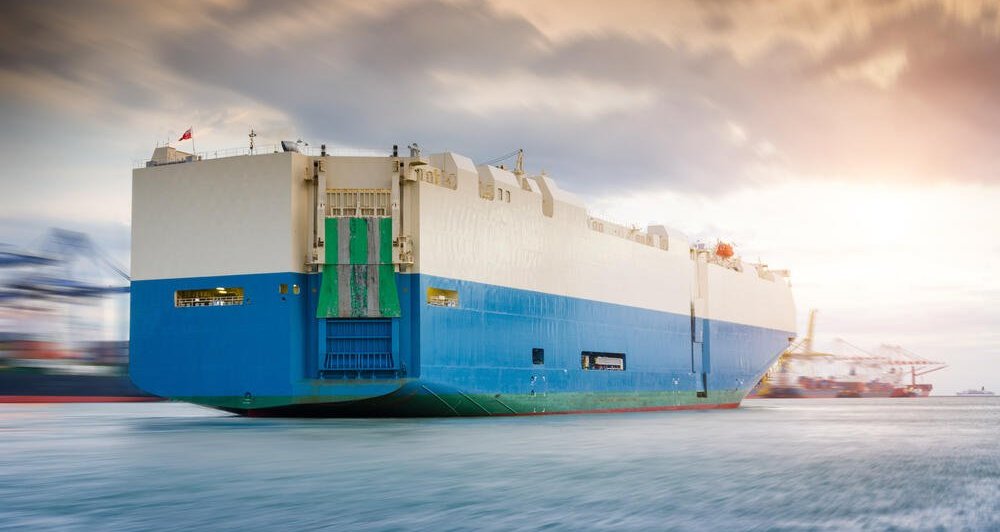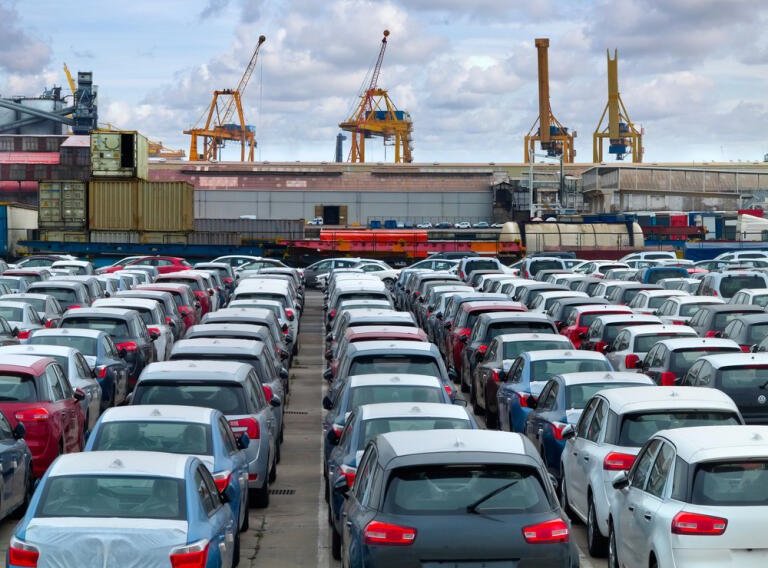
If you’ve ever driven by a port and seen giant cranes unloading countless vehicles, you might wonder just how quickly they can get the job done.
A number of factors go into determining the time for loading and unloading and it’s more complex than a truck driver driving each vehicle down a stern ramp.
The size of the vessel, the number of vehicles being transported, and how road vehicles are stored play a considerable role in the unloading process for the transport of cars. We also have to take into consideration the port itself and the equipment it uses to move vehicles from ship to land.
Let’s begin by learning more about the process of unloading autos from ships.
Overview of the Cargo Ship Industry
Transporting goods and products worldwide would only be viable with the cargo ship industry. These ships have been specifically designed to carry large amounts of cargo across oceans, including cars, containers, and bulk materials like grain or oil.
Cargo ships come in many sizes, from tiny container ships to enormous bulk carriers.
The massive bulk carriers are cargo ships often referred to as “mega-ships.” The two most prominent in the world are the behemoths MSC Irina and MSC Loreto, with a colossal capacity of 24,346 TEU.
Different Types of Shipping
The development of ships has given us many different ways to transport personal items and cars across the world’s oceans. The three most popular methods are:
- Container Shipping: This type of shipping involves transporting goods in containers loaded onto cargo ships. This way of transporting goods is especially popular due to its efficient and cost-effective process.
- Roll-on/Roll-off (Ro-Ro) Shipping: This type of shipping involves loading vehicles onto Roll-off cargo ships and rolling them off at the destination port. The ease of this method makes it perfect for car transport.
- Bulk Shipping: This type of shipping involves large quantities of unpackaged goods such as grain or oil. The cargo is loaded directly into the cargo vessel hold.
Unloading Cars from a Ship
When it comes to vehicle loading and unloading from a ship, the overall process time can depend on how the car has been shipped. If the shipping method is Ro-Ro, then the vehicles are driven onto the ship and parked in designated areas before being secured for transport.
Unloading the vehicles involves reversing the process, with each vehicle being driven off the ship and onto a waiting carrier truck or trailer.
If using container shipping or bulk shipping, once the ship has arrived at its destination port, specialised cranes are used to lift and move vehicles off the vessel.
Trained professionals operate the cranes, carefully manoeuvering the vehicles onto a truck carrier or designated storage areas.

Factors that Affect Unloading Time
Many factors will affect the speed and duration of unloading a cargo ship. But which ones are they? The following are the common ones.
Amount of cargo on board
As you can expect, if the quantity of the cargo is higher, more time will be needed for unloading. A ship carrying hundreds or thousands of vehicles will require more time to unload than a vessel transporting only a few dozen.
What will also affect the unloading process is the arrangement of the cars on board. If motor vehicles are tightly and neatly packed into the cargo decks, it may take longer to unload them.
Crane operators will need finesse and use Tetris-like skills, so they don’t damage any of the cars during the process.
Size of the ship
The size of the ship can also impact the unloading time. Larger ships have more cargo on board, which means more cargo to unload.
The larger ships require more giant cranes to unload the cargo efficiently, and the cranes must be tall enough to reach high above the deck and strong enough to lift heavy items and vehicles.
It’s not uncommon for ports to have several cranes working simultaneously to unload cars from a single ship.
Number of crew members
How many crew members are aboard the ship can also affect the unloading time. The crew is responsible for preparing the vehicles for unloading, such as removing any lashings or securing devices that keep the cars in place during transit.
If there are not enough crew members to prepare the vehicles efficiently, it can slow down the unloading process. How fast and efficiently each crew member works will also affect the transit time.
Having more crew members can also help quickly resolve any issues or delays during the unloading process and keep the overall unloading time to a minimum.
Destination port
The destination port can also influence how long it takes to unload cars from a ship. If the size and capacity of the port result in limited space, this can slow down the process.
Some ports may have specific regulations or requirements for unloading vehicles, such as inspections or customs checks.
If there are a bunch of cars on board, having to check each one individually will undoubtedly increase the unloading time.
Container Ship vs. Cargo Ship
While both container ships and cargo ships serve to transport goods, they do so in different ways.
Container ships carry standardised containers in terms of size and shape, which can be easily loaded and unloaded using specialised cranes. They also usually reach their destination faster, having a higher cruising speed than cargo ships.
Cargo ships are usually more versatile, carrying a more comprehensive range of goods, including motor vehicles.
The downside, though, is unloading cars from a cargo ship can be more time-consuming as the vehicles need to be individually secured and lifted off the vessel.
Cargo ships also require larger cranes to handle heavy items, which can add to the unloading time.
Container ships are generally faster and more efficient for unloading standardised cargo decks like shipping containers. In contrast, cargo ships are more versatile but require more time and specialised equipment to unload motor vehicles.
Containerisation Process and How It Affects Unloading Time
Containerisation has been a God send to the shipping industry and has overall made it a faster, more efficient, and cost-effective procedure.
The main advantage of containerisation is its impact on the unloading time of ships. As mentioned earlier, container ships are specifically designed to carry these containers, which can be easily loaded and unloaded using specialised cranes.
The container size and shape help maximise cargo deck space and minimise the transit time required for unloading. This means a lesser reliance on additional crew members and equipment, which helps slim down the overall time for unloading.
Specialised container terminals at ports have become commonplace thanks to containerisation.
These terminals are designed to handle large volumes of containerised cargo efficiently, with dedicated areas for loading and unloading containers from ships onto trucks or trains. This further speeds up the unloading process and reduces the transit time spent in port.
In summary, containerisation has significantly impacted the shipping industry by reducing unloading times and increasing efficiency.
Standardised containers and specialised equipment have enabled container ships to unload their cargo much faster than cargo ships, which carry a broader range of goods and require more specialised handling.
As the shipping industry continues developing and reducing its overall transport time, containerisation will likely remain a critical factor in the entire process.
Wrapping It Up
Unloading motor vehicles from a ship can be a complicated process that requires specialised equipment and careful planning.
Unlike container ships, cargo ships require larger cranes to handle heavy items like cars. Wheeled vehicles must also be individually secured and lifted off the vessel, which can add to the unloading time.
It will certainly take more than a minute to unload wheeled vehicles if many of them are on board. Plus, the cars’ arrangement will also influence the unloading speed.
On average, unloading cars from a ship can take a few hours to several days. Efficient planning and coordination are crucial to minimising delays and ensuring a smooth unloading process.
JCS Global makes the shipping of cars easy. Request a quote to compare rates and pick a specific service that fits your budget.
Don’t worry about searching through sites upon sites or calling different companies. Give us a call today!





